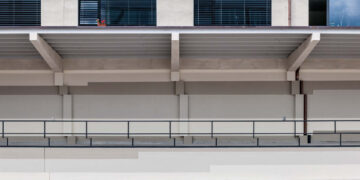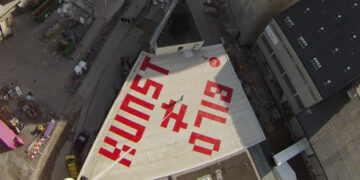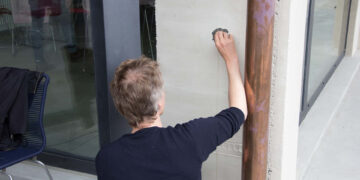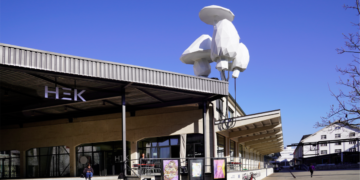Art in architecture

The HEK’s taking up permanent residence in its own building at Freilager-Platz in November 2014 enabled the subsequent realisation of several Kunst-am-Bau (art-in-architecture) projects in and around the museum, which are presented here.
Achim Mohné und Uta Kopp
REMOTEWORDS, 2014

Remotewords by Achim Mohné and Uta Kopp circulates messages on roofs. The latter can only be seen from above but can be spread worldwide through Google Earth once the satellite images are updated. The HEK’s roof installation was also labeled ‘BILD≠Kunst’ by Prof Dr. Hans Ulrich Reck. On the occasion of the house’s inauguration, a drone flew over the building and made the message visible per Live-Stream.
http://www.remotewords.net/pages/portfolio/roofrw-24hek-basel/
Aram Bartholl: Dead Drop, 2010/2014
Dead Drop, 2010/2014

Dead Drops, also referred to as dead mailboxes, is an anonymous and offline peer-to-peer file-sharing network set in public environments. In October 2010, the first USB sticks were installed in New York on buildings, wall crevices, banister rails; and thus became accessible in public spaces. Since then, the idea has enjoyed worldwide resonance and the number of individuals entrusted with the information has widened. Each Dead Drop carries a readme.txt file. Videos, games, music and photos can only be shared with other users and are – unlike they would be on the Internet – not accessible or visible to all.
!Mediengruppe Bitnik (Carmen Weisskopf and Domagoj Smoljo)
H3333333333K, 2015

The installation H3333333333K by !Mediengruppe Bitnik is an intervention in the architectonic structure of the façade, which has allowed a glitch – or visual software failure – to become an architectural construction. The glitch surfaces in places, where work is primarily carried out digitally. It is not just a reference to a tradition in electro music and the digital visual culture, but also an exploration of the motion pictures and the world of computer gaming. The glitch directly stands for a contemporary analysis of artistic production. It is a reflection upon the media, their storage infrastructures as well as their networks – also drawing attention to their underlying technological requirements. As architectural construct, the work alludes to the birth – through glitches – of a shift towards the digital and confers a surreal appearance to the building.
Monica Studer and Christoph van den Berg
A band of floating mushrooms, 2010/2014

On the roof of the HEK appears an installation of interwoven aluminum mushrooms, which stand as metaphor for urban transformation. The paired up members of a band of mushrooms are fixed on a stem joint and, via wire connections, send signals to a PC-Server. In order to listen to the lively stream, it is possible to borrow headphones from the museum as well as to connect to the page https://transit504.ch/bofm/. The work was set up for the first time in 2010 and moved in 2014 to its new location, the HeK.
https://transit504.ch/bofm/